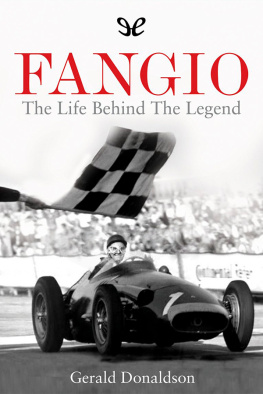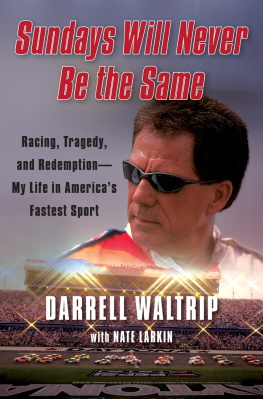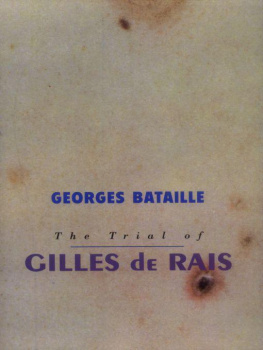CONTENTS
About the Book
Gilles Villeneuve became a legend in his own time, a driver whose skill and daring personified the ideals of Grand Prix racing, the pinnacle of motor sport.
With his flamboyantly aggressive, press-on-regardless style in his scarlet Ferrari, he captured the imagination of a vast international audience as no other driver has in recent times.
His tremendous fighting spirit and pure passion for driving produced so much high drama and deeply felt emotion that Villeneuve became one of the greatest sporting heroes. His enduring legend owes much to its classic elements of tragedy, for he was a charming young man of humble origins who achieved undreamed of fame and fortune by giving his all to the sport that ultimately took his life.
About the Author
Gerald Donaldson is one of the worlds most highly regarded motor sport authors. He has written several books, among them the highly acclaimed James Hunt: The Biography. He has also recently edited Formula 1: The Autobiography.
Also by Gerald Donaldson:
James Hunt: The Biography
Formula 1: The Autobiography
Grand Prix People
Davids Diary (with David Coulthard)
My First Season in Formula 1 (with Jacques Villeneuve)
Teamwork: West McLaren Mercedes
PROLOGUE
Saturday, 8 May, 1982
Zolder, Belgium
It was 1.52 p.m. in the pine forests of eastern Belgium. There were just eight minutes to go in the final qualifying session for the Belgian Grand Prix. The sky was dull and grey after morning showers, but the track surface was dry. The drivers were trying to improve their grid positions for tomorrows race.
None was trying harder than the French Canadian in the red number 27 Ferrari. He came powering through the chicane on full throttle and disappeared over the hill towards Terlamenbocht, one of the most difficult curves on the Zolder circuit. It was to be his last lap.
The engine noises stopped. An eerie hush spread around the 4.26-kilometre track. Spectators whispered nervously at the unexpected silence. Suddenly the track announcer began screaming hysterically about a huge accident involving one of the Ferraris.
Moments later, the scene at the right-hand Terlamenbocht corner bore awful testimony to the enormity of the crash. Bits and pieces of wreckage of the Ferrari were strewn along the circuit for some 200 metres. There, in the middle of the track, was the utterly destroyed chassis, shorn of all bodywork, with only the right rear wheel remaining and the entire front of the car sheered off at the point where the driver once sat.
Beyond the car, amid the tangled wire of the catch-fencing on the outside of the curve, distraught track marshals stood wringing their hands in anguish. Quickly, they held up a curtain of blankets to shield onlookers from the view. Their agitation increased as running crowds converged on the area and the marshals, joined by police wielding truncheons, began physically to beat back the spectators.
At 2.03 p.m. the track announcer said Gilles Villeneuve was being taken by helicopter to a nearby hospital. Shortly after came another announcement from the organisers. Couched in careful terms, it was given first in Flemish and then in French, the official languages of Belgium, then in English: The front left wheel of the number 27 car hit the right rear wheel of the number 17 car. Car number 27 was then thrown in the air, and having come down several meters further, the driver was ejected from his seat into the catch fences. The driver is very seriously injured.
In the pits the Ferrari team closed the steel doors of their garage. Personnel on other teams exchanged worried glances. People stood around in small groups, talking quietly. Some, who watched the accident replayed on television monitors, wept unashamedly, as had certain drivers who had stopped at the crash site.
The remaining eight minutes of practice resumed but only six cars went around for a few half-hearted laps. The teams packed away their equipment for the day. The Ferrari team loaded everything, including the twisted pieces of metal that once were the number 27 car, into their transporters and left for Italy.
In the Zolder press room journalists sent the news to a waiting world, updating it with the periodic announcements issued by the doctors attending the accident victim. At 5.40 p.m. it was officially announced that Gilles Villeneuve was unconscious and suffering from severe injuries to his neck and brainstem. His vital functions were being maintained by intensive care.
Then a last bulletin was issued from the University of St Raphael Hospital in Louvain, Belgium. Gilles Villenueve died at 9.12 p.m.
The members of the international press went back to file their final stories. Several of them were crying. One veteran writer from Brazil spoke slowly: You know, my greatest regret today is that I hardly knew Gilles at all. I couldnt do anything about it. I was so impressed by him that I hardly dared talk to him
1. EARLY TIMES: 19501974
It was a clear, hot summers day with no one around but us, so my father let me drive. What a thrill!
Gilles Villeneuve
JOSEPH GILLES HENRI Villeneuve was not born on 18 January 1952 as most record books show. He was two years older than that but hid it from public view in the belief that his real age might be a barrier to progress in his career. He was a relative latecomer in his chosen profession because, given his unexceptional beginnings, Gilles Villeneuve needed extra time to achieve his extraordinary success.
His father was an itinerant piano tuner. Seville Villeneuve lost his father when still a young boy and left school early to work as a handyman and jack-of-all-trades, picking up the necessary skills along the way. As a teenager Seville was taken in by a married couple, the Montagnes, who had no children of their own, and Seville came to regard them as his foster parents. Monsieur Montagne, a piano tuner, discovered that Seville had an ear for music and for many years the two of them travelled to the far corners of the province of Quebec to ply their trade.
Seville was 23 when he married Georgette Coupal, whose family owned a small construction business. Their wedding took place on 21 June 1947 in Chambly, Georgettes home town on the Richelieu River about 30 kilometres east of Montreal. For several years they lived just across the river in the town of Richelieu. At six in the morning on a frosty 18 January in 1950, Georgette gave birth to Gilles in the Saint-Jean-Sur-Richelieu hospital. Another son, Jacques, was born on 4 November 1953, and the Villeneuve family was complete.
The Villeneuves were close but Georgette and the boys were often left alone for lengthy periods of time as Sevilles piano-tuning took him hundreds of miles away to such places as the Gasp Peninsula. Her husbands income was modest but Georgette was a good mother and homemaker and their household was a happy one. Little Gilles was fascinated by anything mechanical, particularly the construction equipment operated by his uncles. His favourite toys were bulldozers and lorries but they had to be realistic, with exactly the right number of wheels and axles, or he wouldnt play with them. He would take them apart and put them together again, no matter how complicated they were. Seville built him a sandbox in the backyard where Gilles amused himself for hours on end, painstakingly building miniature roads and bridges with his toy machines. When his roads were built he pushed the machinery around the curves as fast as he could, accompanying them with high-pitched noises in imitation of engines being stretched to their limits.
Next page










